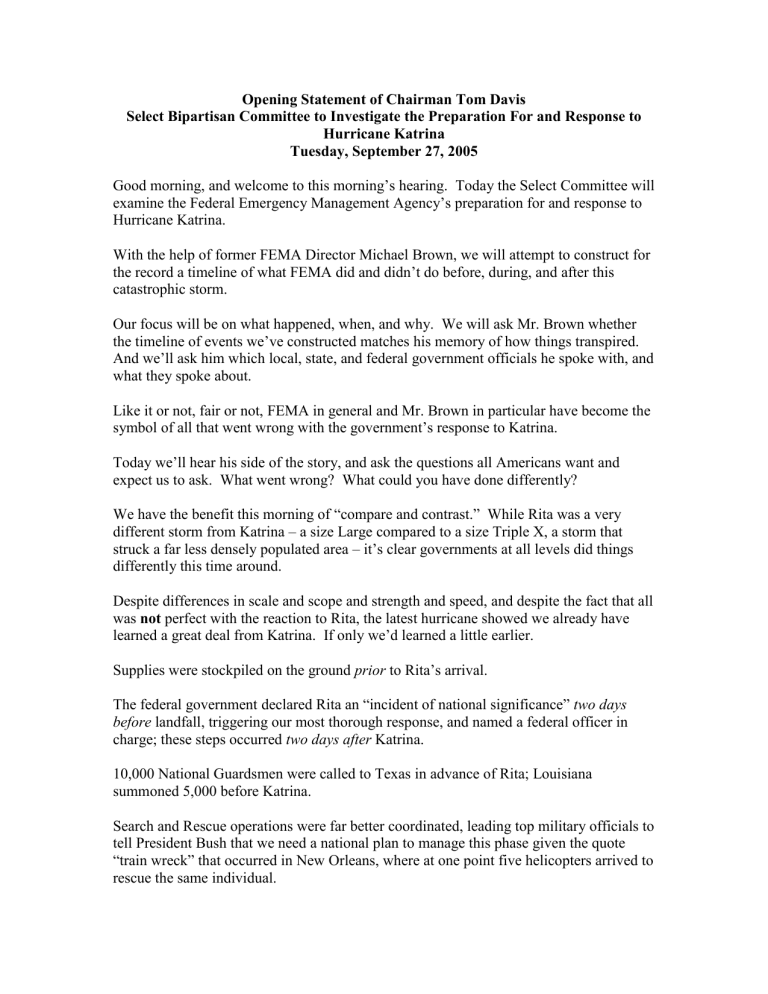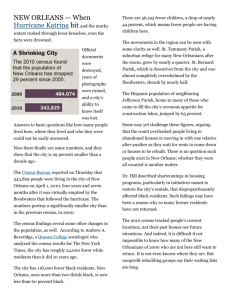Opening Statement of Chairman Tom Davis

Opening Statement of Chairman Tom Davis
Select Bipartisan Committee to Investigate the Preparation For and Response to
Good morning, and welcome to this morning’s hearing. Today the Select Committee will examine the Federal Emergency Management Agency’s preparation for and response to
Hurricane Katrina.
Hurricane Katrina
Tuesday, September 27, 2005
With the help of former FEMA Director Michael Brown, we will attempt to construct for the record a timeline of what FEMA did and didn’t do before, during, and after this catastrophic storm.
Our focus will be on what happened, when, and why. We will ask Mr. Brown whether the timeline of events we’ve constructed matches his memory of how things transpired.
And we’ll ask him which local, state, and federal government officials he spoke with, and what they spoke about.
Like it or not, fair or not, FEMA in general and Mr. Brown in particular have become the symbol of all that went wrong with the government’s response to Katrina.
Today we’ll hear his side of the story, and ask the questions all Americans want and expect us to ask. What went wrong? What could you have done differently?
We have the benefit this morning of “compare and contrast.” While Rita was a very different storm from Katrina – a size Large compared to a size Triple X, a storm that struck a far less densely populated area – it’s clear governments at all levels did things differently this time around.
Despite differences in scale and scope and strength and speed, and despite the fact that all was not perfect with the reaction to Rita, the latest hurricane showed we already have learned a great deal from Katrina. If only we’d learned a little earlier.
Supplies were stockpiled on the ground prior to Rita’s arrival.
The federal government declared Rita an “incident of national significance” two days before landfall, triggering our most thorough response, and named a federal officer in charge; these steps occurred two days after Katrina.
10,000 National Guardsmen were called to Texas in advance of Rita; Louisiana summoned 5,000 before Katrina.
Search and Rescue operations were far better coordinated, leading top military officials to tell President Bush that we need a national plan to manage this phase given the quote
“train wreck” that occurred in New Orleans, where at one point five helicopters arrived to rescue the same individual.
Even if a little rough around the edges, the massive pre-storm evacuation of Houston and surrounding locales showed improved foresight from state and local officials – and how lives can be saved when people pay attention to a coordinated message from their government.
While questions remain about inadequate fuel supplies along evacuation routes and delays in converting highways into one-way, outgoing routes, the relative urgency in getting people out of harm’s way was night and day. There’s just no easy way to quickly move millions of people.
I think we’ll hear from Michael Brown today that none of this is easy. And with Katrina, he faced a big, big storm.
It’s no doubt true, and problematic, that many Americans – and perhaps even some state and local officials – falsely view FEMA as some sort of national fire and rescue team.
An important task for this committee moving forward will be getting an accurate description for the record of what FEMA is
– what it can and cannot do based on what it is actually charged with doing.
FEMA is not a first responder agency with the resources to assume principal responsibility for overwhelmed state and local governments during a disaster.
This is not the movies. There is no Tommy Lee Jones character who comes in and takes charge of…well… everything .
And that’s probably a good thing. I continue to believe the worst lesson to be learned from Katrina is that all answers reside in Washington.
But before getting to what FEMA cannot do , let’s understand what they simply did not do.
Just because they’re not “first responders” doesn’t mean they should be a second thought.
It’s not like we’re talking about the DMV here. We’re talking about the federal agency charged with coordinating response to massive disasters. It’s no big surprise that FEMA has ranked last or near last for several years in surveys rating employee morale at large federal agencies.
Today we seek to find out what happened – and didn’t happen – on the ground.
Then we can work backward (beginning, no doubt, today) to discover what may have caused or enabled failures in preparation and response.
Maybe we’ll end up discovering that it’s some mixture of the following: Inadequacies or naïveté in the Stafford Act. Organizational or budgetary shortcomings. State and local
governments that didn’t know how to ask for help, or simply didn’t. A bureaucratic mindset that now emphasizes terrorism to the exclusion of natural disaster planning.
We’ll explore these possibilities, and more.
Today we’ll ask about reports that so many who wanted to help were prevented from doing so by the government. About ice and water trucks diverted elsewhere. About physicians and other health care providers told to stay home. About FEMA emergency phone lines busy for hours on end.
When Michael Brown admitted to reporters that he didn’t know thousands of survivors were stranded at the New Orleans Convention Center without food or water – even though TV journalists had been reporting that fact for hours – his appearance before us today became inevitable.
We’ll ask Mr. Brown’s opinion on why all residents were not evacuated, why the levee system failed, and why relief and medical supplies were so slow in arriving. And we’ll do so with the unfortunate knowledge that more than one study or exercise gave officials at all levels ample notice about what a big storm could do along the Gulf Coast, particularly to New Orleans.
FEMA scientists participated in the now-widely-known exercise called Hurricane Pam in
July 2004, an exercise that predicted with eerie similarity Katrina’s impact on New
Orleans, including an evacuation of a million people, overflowing levees, and the destruction of hundreds of thousands of buildings.
Dr. Kathleen Tierney, director of the Natural Hazards Center at the University of
Colorado, Boulder, said on a recent radio program that government missteps along the
Gulf Coast were “absolutely avoidable.” It was “common knowledge,” she said, that the levees could not withstand more than a category 3 storm, that thousands of residents without cars would be stuck if an evacuation order was given, and that hesitancy in issuing mandatory evacuations would prove devastating.
Even 2003’s Isabel, a much smaller hurricane, offered lessons for FEMA, based on an oversight hearing we held in the Government Reform Committee. Two years ago in
Virginia, we heard disturbing tales of slow federal response and near-invisible coordination.
We don’t yet know why FEMA failed. That’s why we’re having this hearing, why we continue to gather documents, and why our investigators will soon be on the ground in
New Orleans and elsewhere.
At the end of the day, I suspect we will find that government at all levels failed the people of Louisiana, Mississippi, and Alabama. I believe we will hear from Michael
Brown, for example, that there simply was no unified command structure or clear lines of authority in Louisiana.
That means we’re confronted with profound questions about not only what went wrong with FEMA, but what may be wrong with our government at all levels when it comes to disaster preparation and response.
Are we lacking a culture of urgency? A culture of getting things done?
Or is it that, even when we have the best possible planning and prediction available, we come face to face with the vast divide between policy creation and policy implementation?
After Katrina, the American people are wise to the fact that a policy that cannot be implemented effectively is no policy at all. This Committee’s charge is to address the life-and-death difference between theory and practice.






